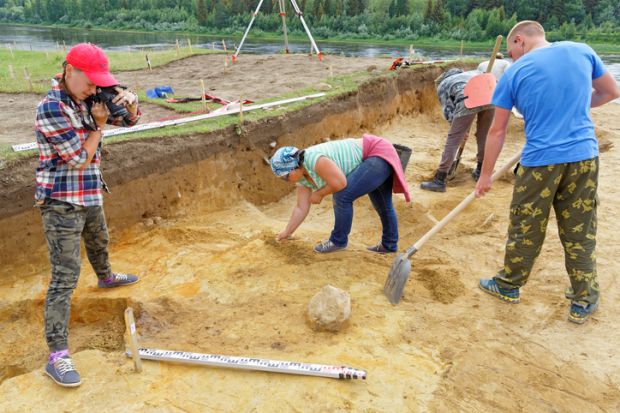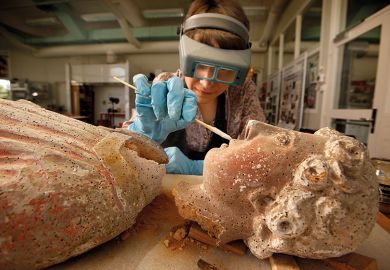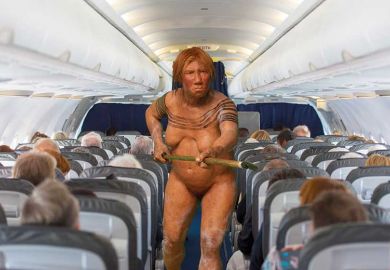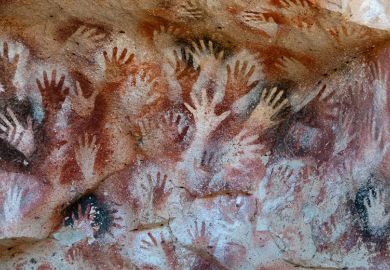Archaeologists love getting stuck into a good debate. Over the past few weeks, there has been much discussion over the recently released Netflix film The Dig, a dramatisation of the 1939 discovery of Sutton Hoo, an Anglo-Saxon ship burial in Suffolk in eastern England.
Based on the 2007 novel by John Preston, the star-studded film focuses on the tangle of relationships involved in the excavation, and foregrounds the process of discovery itself, against a backdrop of vast East Anglian skies and impending war. Archaeologists quickly took to social media and blog platforms to voice their opinion. Some were dismayed at the portrayal of archaeologist Peggy Piggott (Lily James) as inexperienced, when in real life she was a seasoned excavator. Many found both her fictitious affair and the portrayal of husband Stuart Piggott’s sexuality problematic. Others picked up on the inaccuracies: the wrong type of trowels, the wrong type of mud, the lack of measuring tapes and planning frames.
On the opposite side were those who relished seeing a famous excavation shown in such detail, enjoyed the portrayal of the skill and passion of the excavator Basil Brown (Ralph Fiennes), and felt the film conveyed a strong sense of the physical work, camaraderie and exhilaration that we are all familiar with from days in the field.
An underlying theme throughout the film is the professional and class conflict between Brown, a local paid by landowner Edith Pretty (Carey Mulligan) to investigate, and representatives of the archaeological establishment brought in by the Office of Works and the British Museum to oversee the excavations once the significance of the site had become clear. When the University of Cambridge’s Charles Phillips (Ken Stott) arrives with his team to take command, poor Basil naturally takes affront at being sidelined. In real life, there were signs that the relationship between them was strained but, as in the film, they put aside their differences to work on the spectacular discovery.
You might think that British archaeology had left behind clashes of class and types of professional expertise long ago, along with plus fours and cigarette holders. Sadly, this is not necessarily the case. The equivalents of Basil Brown work within the commercial archaeology sector, excavating and recording ahead of development as part of the planning system. The work isn’t easy, glamorous or particularly well paid, and it continues through wet winter days and scorching summer heat. But is a highly specialist task, incorporating many skill sets and sub-disciplines. And it is important, recording historical evidence that would otherwise be destroyed.
The establishment, meanwhile, could still be characterised as those who teach and research in universities. I should precede what I’m about to say with a substantial caveat – that there are many outstanding people working in academic institutions, all of whom could point to excellent projects and working relationships where expertise is shared, both with colleagues in the commercial sector and those who work for local authorities, national organisations and museums. But I would argue that there remain some of the kinds of divisions seen between Basil and Charles at Sutton Hoo.
In a letter to The Times published in November 2020, 17 academics – all male, but that’s an issue to discuss another day – wrote concerning the A303 tunnel near Stonehenge. “The proposed archaeological excavations will be partial at best, allowing the recovery of only a tiny percentage of artefacts and buried features,” they wrote. “Half a million artefacts are destined for oblivion: they will be destroyed without trace by mechanical excavators.”
This is not the place, either, to debate the merits of a new road tunnel across a World Heritage Site, nor to delve deeply into the correct percentage of topsoil to be sieved. But it is worth noting the entrenched academic perspectives that the letter highlights regarding commercial archaeology. The mitigation work on the A303 will be carried out by highly skilled professional field archaeologists from a private-sector company who have vast experience of working in the area. And their work will be closely guided by further experts in local government and national organisations, with standards beyond what is usually required because of the significance of this landscape. It seems harsh to equate all this with casting the site to oblivion.
On the other hand, commercial archaeology is done under huge pressure, with little time for long debates about methodology or the testing of new research techniques, while developers tend to go for the cheapest contractor. That is hardly a conducive environment for academic involvement.
So how does archaeology move on from such them-and-us attitudes, towards a sense of archaeology in all sectors as a more coherent body of researchers?
Part of the solution is unionisation in the commercial sector, with decent terms and conditions that recognise and reward the vast expertise within its employees; Basil Brown negotiating over his pay at the start of the The Dig would have been pertinent to many. But there also needs to be greater effort on both sides to collaborate. The Stonehenge tunnel and other major infrastructure projects provide unique opportunities for partnership working, involving academic input through all stages of the project, alongside collaborative analysis and interpretation – allowing synthesis at a large scale.
Such collaboration could also offer training for students – many of whom, after all, end up being employed in the commercial archaeology sector. And it could help develop innovative public engagement that, following up on The Dig, will further stoke people’s interest in the fascinating process of archaeological discovery.
In the words of Basil Brown, “That speaks, dun it? The past.” Archaeologists must set aside their differences and work together to allow it to be heard.
Susan Greaney is a PhD candidate in archaeology at Cardiff University.
Register to continue
Why register?
- Registration is free and only takes a moment
- Once registered, you can read 3 articles a month
- Sign up for our newsletter
Subscribe
Or subscribe for unlimited access to:
- Unlimited access to news, views, insights & reviews
- Digital editions
- Digital access to THE’s university and college rankings analysis
Already registered or a current subscriber?








